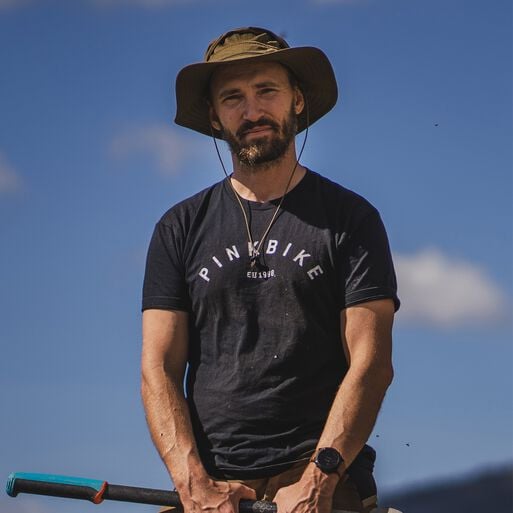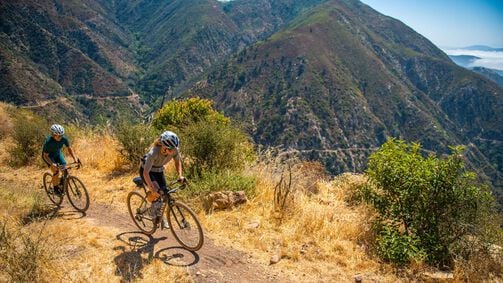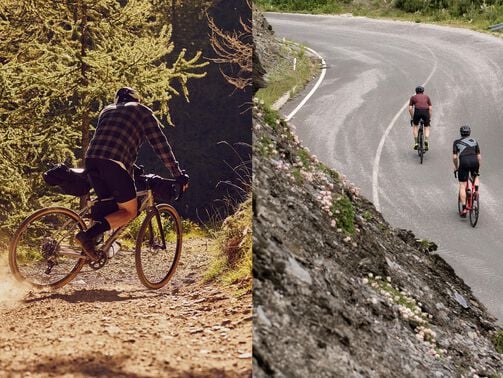Gravel biking for beginners: How to choose the best entry-level gravel bike
Want to try gravel riding? Find the right entry-level gravel bike, gear and rides for you.


Gravel riding is the fastest-growing discipline in cycling. It has hit the sweet spot for many people - calmer and closer to nature than road cycling, more focused on covering distance and enjoying the whole ride than mountain biking. It has so much to offer that it can easily become confusing for a new rider.
People talk about gravel being on a spectrum. This means that there are many different interpretations of gravel riding. For many it is relaxed rides around their local countryside, for some, it is heading off into the wild blue yonder and for others it is all about racing and speed. This guide will walk a beginner through how to find the right gravel bike for you, the basic kit you will need and how to find rides near you.
Contents
Why start gravel riding?
“I think gravel is a nice in-between way of riding.” Having ridden around the world not just once, but twice, adventurer and Canyon gravel athlete, Vedangi Kulkarni, knows more than most about spending time in the saddle. “Some days you don't want to go out on a road bike and deal with the traffic. You can ride on forest tracks, where it's unlikely that you'll come across vehicles, and you can go somewhere wild. It's a good start for riding off-road, it’s less demanding and I think it is a more fun way to be off-road than on a mountain bike.”
Today we find more and more people agreeing with Vedangi. It seems like in the last few years the roads are getting angrier and more crowded. For road cyclists, gravel offers more access to nature and escape from the cars, for mountain bikers, it opens the door to long-distance riding, and for beginners, it is the simplest cycling discipline to start with.
What sort of entry-level gravel bike do I need?
There are so many ways of riding gravel that one bike will never fit everyone. This is why we have broken our gravel range into the Grizl OG, Grizl Escape and the Grail. Each of them would make a great beginner’s gravel bike, the question then is: what type of riding do you want to do? Vedangi’s top tip is to “Ask what's the widest tire I can put on it? Because that increases what the bike is capable of.”
Grizl AL
The Canyon Grizl AL embodies everything a beginner-friendly gravel bike should offer: versatility, reliability, and great value for money. Its lightweight yet durable aluminum frame and relaxed geometry make both long stretches of pavement and rough terrain a pleasure to ride. As a beginner, you’ll enjoy using this gravel bike for relaxed rides – and later, for more demanding adventures or even extended bikepacking trips.
Grizl OG
Simple, tough and capable, the Grizl is equally at home in your local woods or trekking up a far-flung mountain, Vedangi uses hers for everything. “Every time I head out with my Grizl I have it in my head that I can take this bike anywhere. Living in Scotland, I can go out on a road ride and then I might see something off-road that I once saw on a train or something and then be like, “Oh, where does that gravel track go?” if it leads to the top of a mountain, great. If it doesn't, I've just explored a new place.”
Grizl Escape
A new addition to our range, the Grizl Escape is designed for riders who want to take on the biggest of rides. With our innovative Full Mounty handlebar, adventure-ready wide-range gearing and big tyres, it is ready to go as far as you can imagine.
Grail
The Grail is our fast gravel bike. With lower and longer geometry, it feels like a road race bike for the dirt. “I would say that if you didn't want to buy two bikes, a road bike and a gravel bike, then you would choose something like a Grail. You can do everything and it feels like a road bike, but it still rides like a gravel bike,” explains Vedangi. And she should know, because she rode around the world on hers.
Do I need a carbon or aluminium frame for gravel riding?
Most of our gravel bikes have carbon frames today. For long-distance riding, we think that the weight and ride-feel benefits of carbon are undeniable (click to see our range of carbon gravel bikes). However, we realised that these bikes were hard to reach for beginners, so we have a more affordable, aluminium versions of the Grizl (check out our aluminium gravel bikes here). Stiff, rugged and capable just like its carbon counterpart, we think beginners will love it as a great bike for their first off-road adventures.
Our tip: As a gravel beginner, you can’t go wrong with a bike like the Grizl AL. You’ll save money, still get a high-quality bike, and can always upgrade to carbon later once you know your preferences better.
| Advantages of carbon frames | Advantages of aluminum frames |
|---|---|
| Significantly lighter than aluminum | Significantly more affordable |
| Better vibration damping for increased comfort | More robust for everyday use |
| Stiffer for optimal power transfer | Easier to repair |
| More durable with proper care | Perfect for beginners |
Do I need suspension on my gravel bike?
No, is the honest answer. For most people, suspension offers cost, weight and complexity that you can live without on an entry-level bike. These days, suspension is mostly associated with racing and extreme adventure, which is why we offer it on high-end models like the Grail CFR Di2 RIFT and the Grizl CF8 RIFT. If you are just looking for some easy rides to try the sport it is not something you need to worry about.
Do I need to worry about my wheel size?
No. While mountain bikes have several wheelsizes to choose from, all of our gravel bikes use standard 700c wheels, all the way down to our XXS sizes. In the past, some bikes have come with 27.5-inch wheels to allow riders to fit larger tyres. Today, we have designed our bikes to accept 700c wheels and wide tyres. The Grail has room for comfortable 42mm tyres, while the Grizl goes all the way up to 50mm, so we don’t see a need to add a second wheel size.
Ask what's the widest tire I can put on it? Because that increases what the bike is capable of.Vedangi Kulkarni

Do women need different gravel bikes?
In the past, we have made women-specific models, but today we believe that bike fit is the most important factor in finding the right bike for both men and women and do not make gender-specific bikes. Our Perfect Positioning System takes around five minutes with some household items, it can be done on your own (it is easier with the help of a friend) and 98% of customers report getting a great-fitting bike with it.
Not sure what gravel bike size you need? Use our complete gravel bike sizing guide to find the right fit for comfort, control, and performance on any terrain.
What essential gear do I need to start gravel riding?
As a beginner, it can be bewildering trying to make sure you have all the right gear. If you start digging into it there are so many things you could think about, how do you tell which ones you need? The good news is that we think you only need a few essentials to get started:
A good helmet
No cyclist should be without a good helmet, it’s that simple. If you are starting from scratch, this is always the most important piece of kit to buy first, and it is worth investing as much as you can to make sure you get a high-quality helmet. We’d recommend one with good ventilation and a system to protect against rotational impacts, like MIPS, if you can afford it.
Chamois
Professional cyclists have chamois sewn into their riding kit, but if you are on a tight budget maybe good quality cycling gear is too far for now. There is no reason why you cannot ride in whatever clothing you have, ideally, it should be light and move well to allow you to pedal freely, but we would recommend adding a short liner. Little more than a foam pad sewn into an undershort, you can slip one of these underneath your clothing to help keep your intimate areas comfortable when riding (Discover performance-ready cycling clothing here.)
Water and food
If you are going to start doing longer rides, you are going to need to be able to take water and food with you. As the idea of gravel riding is to get away from civilisation, that means you may not find a handy cafe or shop to help you keep going. You don’t need to over-complicate things though, and water and a banana should keep you going on a short ride. If you start to go longer, things like energy bars are worth considering because they pack a lot of calories into a small space. All of our gravel bikes offer plenty of mounting points and storage options to help you carry everything you need with you (Visit our bike accessories category to gear up your ride.)
Cycling tools
As with water and food, when you start heading out further you need to think about mechanical problems. Sooner or later you will get a puncture or other small issue. If you have an inner tube, a small pump, a set of tyre levers and a good multitool, then that should be able to save yourself the long walk home nine times out of ten (Check out our cycling gear and bike maintenance collections here.)
Storage
Of course, if you need to carry tools, food and water with you, you are going to need to find some way of carrying them. There are many ways of doing this, like frame mounts, frame bags and backpacks, it is quite a personal thing, so you may need to experiment a little to find the best way for you and your budget. Vedangi explains, “I've always ridden gravel bikes where I have a really good top tube bag to keep things in so nothing is on me because people crash and break things.”

What is the gravel mindset?
While easy gravel rides are just that, easy, some people need to go further and harder. When you start to venture away from civilisation gravel riding becomes something else. If you have not done a long-distance sport before, it will likely change your relationship with the world.
The simple math is that if you ride long enough and far enough, bad weather will find you. Challenges will arise, bikes will break and people will pick up injuries. Even with all the preparation in the world, it can still get really tough if you’re a long way out from the world. We don’t write this to put you off, rather this is one of the core appeals of gravel riding. In a world that is becoming more and more convenient and easy, for some people, gravel riding is about choosing to do hard things and that is why they love it. This is what people refer to as having a gravel mindset.
How do I find places to ride near me?
Unlike mountain biking, where you have to deal with complex rights of way and access issues, it is usually pretty simple to find places to ride gravel. Most common maps will show gravel and dirt roads on them, although you will still need to check your route as they may not show private property signs and things like that.
What regular maps will not show you is the profile of the ride you are taking on. For this, and to see where other people around you are riding, it is well worth checking out apps like Strava and Komoot.
If you would like some company on your rides, your best bet will be to find a local club or shop that organises group rides. These kinds of rides are a great way to meet other riders and discover the best riding spots in your area.
Preparing your gravel bike for the ride
Our bikes arrived 80% assembled with the tools and instructions included to get you out and riding. However, there are still some basic checks you should make before your first ride. First, you should check the saddle height. At the bottom of the pedal stroke, your leg should be slightly bent to leave enough space to raise yourself up and off the saddle in an emergency.
You will want to make sure that your stem is straight, your bars are tilted to a comfortable angle and your shifters are comfortable for you to ride on. It is worth investing some time in doing this because what may feel like a minor issue in the car park may be very uncomfortable after a couple of hours riding on rough ground. It is also worth making sure your brakes and gears are working correctly before you head out.
Tyre pressure is another area worth investing some time in before your first ride. As so much of the comfort for the ride is in the tyres, getting them right can change your whole experience. We wrote this short guide to tyre pressure for gravel riding to help get you started.
If you do not feel confident doing any of this, we would always recommend seeking the help of a professional mechanic.
Begin your gravel bike adventure!
Hopefully, by now you have chosen your beginners’ gravel bike, know what kit you need and where you want to ride. All that’s left to do now is go and ride - the best part! If you are still not sure what sort of gravel bike you need, we’d recommend visiting one of our Experience centres. The team there will be able to help you figure out which bike is right for you. They can even set up test rides and will have some good tips on where to ride near you.
With such a wide range of bikes to choose from, we know it can be a little intimidating to try and work out which one would suit you. That is why we have produced this comprehensive buying guide to our gravel range to walk you through our bikes to find your perfect partner. If you would like to compare individual models you can use our easy-to-use bike comparison tool.
And that’s a wrap - have an awesome time discovering new roads and trails on your first gravel bike!
Discover our Gravel Bikes
Did this article help?
Thank you for your feedback
-
 About the author
About the authorMatt Wragg
Get to know Matt Wragg, the freelance photographer, writer, and self-proclaimed bicycle-breaker based in Nice, France. Despite unsuccessful attempts at XC, trials, 4X, and DH racing, Matt's passion for mountain biking never waned. After a stint in communications consulting, he decided to pursue his love for cycling and moved to New Zealand. Since then, he has traveled the world, chasing trails and building a successful career as a cycling photographer and writer. In 2021, he was diagnosed as autistic and has been coming to terms with it. His bike cellar is a true testament to his love for cycling, housing bikes that range from freeride to cargo.








